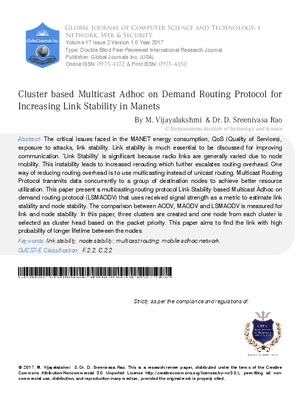Abstract
The critical issues faced in the MANET energy consumption QoS Quality of Services exposure to attacks link stability Link stability is much essential to be discussed for improving communication Link Stability is significant because radio links are generally varied due to node mobility This instability leads to increased rerouting which further escalates routing overhead One way of reducing routing overhead is to use multicasting instead of unicast routing Multicast Routing Protocol transmits data concurrently to a group of destination nodes to achieve better resource utilization This paper present a multicasting routing protocol Link Stability based Multicast Adhoc on demand routing protocol LSMAODV that uses received signal strength as a metric to estimate link stability and node stability The comparison between AODV MAODV and LSMAODV is measured for link and node stability In this paper three clusters are created and one node from each cluster is selected as cluster head based on the packet priority This paper aims to find the link with high probability of longer lifetime between the nodes The simulation are carried out and compared the result of the proposed routing protocol LSMAODV based on minimum hop count Analysis of simulation results show improvement of various routing performance metrics such as routing overhead and packet drop ratio
This work is licensed under a Creative Commons Attribution 4.0 International License.
Copyright (c) 2017 Authors and Global Journals Private Limited

